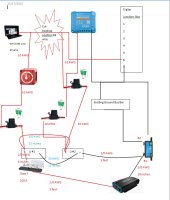Hi, I'm changing over to lithium batteries and adding a 2000W inverter in a travel trailer. Looking for any feedback/comments on my proposed install.
In order to keep power for the electric trailer brakes , I'm splicing into the 12V line from the power distribution center (WFCO) that goes out to the trailer junction box. One side of the splice will come from the battery to power the brakes all the time. The other side of the splice will send 12V power to the WFCO via a switch.
Thank you

In order to keep power for the electric trailer brakes , I'm splicing into the 12V line from the power distribution center (WFCO) that goes out to the trailer junction box. One side of the splice will come from the battery to power the brakes all the time. The other side of the splice will send 12V power to the WFCO via a switch.
Thank you



